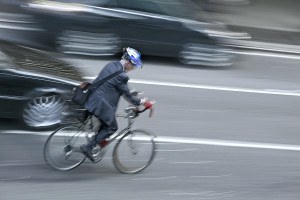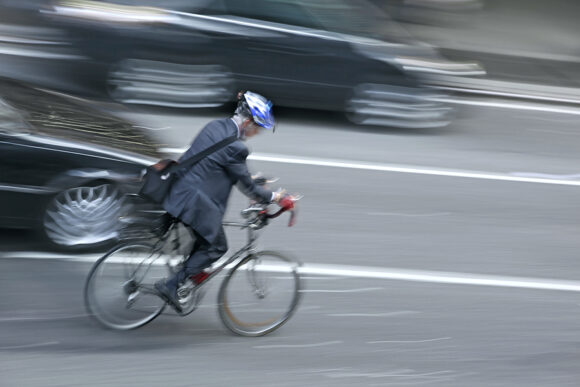 Road cyclists call it getting buzzed – when a car passes by so close that the vehicle almost hits the cyclist or runs the cyclist off the road.
Road cyclists call it getting buzzed – when a car passes by so close that the vehicle almost hits the cyclist or runs the cyclist off the road.
In Pennsylvania it could soon be illegal to pass a bicycle unless there’s at least four feet of space between the vehicle and cyclist.
Sandy Shoop of Boiling Springs isn’t a cyclist but drives almost daily on State Route 641, a two-lane road.
“That will be very dangerous,” she said of the proposed four-foot law. “You might as well stop behind (the cyclist) and let the other car pass by” in the other lane before passing the bicycle.
Maybe not stop, but at least slow down, or not pass until it is safe to do so, bicycling advocates say.
Pennsylvania would join 19 other states that have approved what advocates refer to as safe passing laws.
The state House passed the proposal in 2011. The legislation now awaits action in the Senate.
Joe Stafford, executive director of the Bicycle Access Council in Dallastown, said that besides setting a safe passing standard, the proposal would clear up some gray areas in state law about vehicles and bicyclists sharing Pennsylvania roads.
“This is not special interest legislation, but to avoid misunderstandings by law enforcement, the general public and cyclists,” Stafford said.
The proposal would clarify that it’s legal for a vehicle to cross the double yellow line on a two-lane road, if that is necessary to provide the four-foot clearance when passing a cyclist.
The law wouldn’t make it legal to cross the center line into oncoming traffic. In that case, under the new law a motorist would have to wait until traffic clears in the oncoming lane to pass the cyclist.
Even without the law motorists often can’t pass a cyclist on a two-lane road without going into the other lane. That’s how it should be, said Jeff McPartland, a cyclist from Camp Hill.
He said bicycle safety instructors recommend a cyclist ride in the road – in line with a car’s right passenger tires – to discourage motorists from passing until it’s safe.
“When you are far to the right and pushing that edge they try to squeeze by you,” he said. Riding in the road also reduces chances of a cyclist getting a flat tire, because sharp items and debris are swept to the edge and into the shoulder by traffic.
McPartland cautioned he doesn’t ride in the lane on heavily congested roads like the Carlisle Pike.
The legislation would also make it illegal to turn right into the path of a cyclist – what Stafford said cyclists refer to as a “right hook.”
It would also make it legal for a cyclist to be going less than the minimum speed – which Stafford said means a cyclist with traffic behind him or her wouldn’t have to move off the road or as far to the right as possible.
Stafford said the law doesn’t make exceptions for narrow roads. If there isn’t enough room to pass and give four feet, you’ll have to wait until you have room, he said.
Bob Mionske, a lawyer from Portland, Ore., who specializes in bicycle law, said in general laws like the one being considered in Pennsylvania are a good idea. But Mionske said the laws are not enforced.
Tennessee has had a three-foot law several years but Mionske said police have never cited anyone for violating it.
Finding a witness to verify someone passed a cyclist without leaving enough room is also a challenge, Mionske said.
He said these laws must be accompanied by strong efforts to educate the drivers and police officers. Drivers’ education courses need to do a better job of telling young drivers what they should know when it comes to cyclists, he said.
In 2010, 1,485 crashes involving a bicycle were reported throughout Pennsylvania, compared to 1,401 in 2009, according to the Pennsylvania Department of Transportation.
Pennsylvania ranked 10th nationwide with 15 bicyclist traffic deaths in 2009, according to the National Highway Traffic Safety Administration. Florida had the most bicyclist fatalities in 2009, 107.
Stafford said violations would be summary offenses, typically a fine of up to $35 with court costs bringing the total to $100 or so. He didn’t know if drivers will be assessed points.
He doesn’t know of any research showing a link between safe passing laws and a drop in bicycle accidents or deaths, and concedes enforcement will be a challenge.
“It’s impossible to go out with a tape measure” and gauge if someone passed a bicycle with less than four feet of space, Stafford said. “The intent is to introduce a margin of safety for bicyclists.”
(The (Harrisburg) Patriot-News)
Was this article valuable?
Here are more articles you may enjoy.


 Surging Oil Tanker Insurance Points to Growing Black Sea Chaos
Surging Oil Tanker Insurance Points to Growing Black Sea Chaos  First Brands Judge Approves Examiner to Probe Fraud Allegations
First Brands Judge Approves Examiner to Probe Fraud Allegations  US Lawmaker Unveils Bill Requiring Manual Car-Door Releases
US Lawmaker Unveils Bill Requiring Manual Car-Door Releases  Allianz Built An AI Agent to Train Claims Professionals in Virtual Reality
Allianz Built An AI Agent to Train Claims Professionals in Virtual Reality 